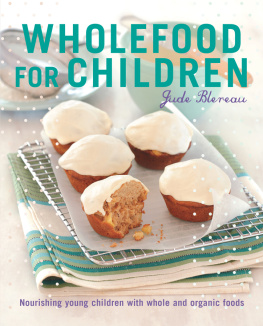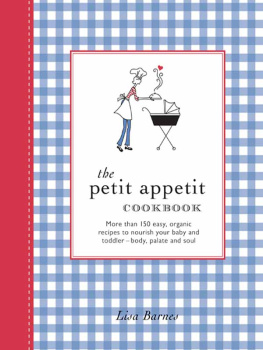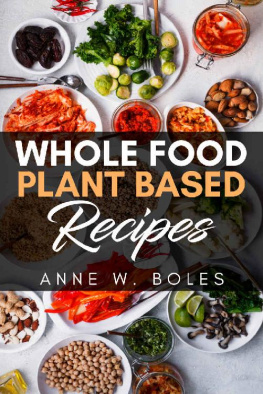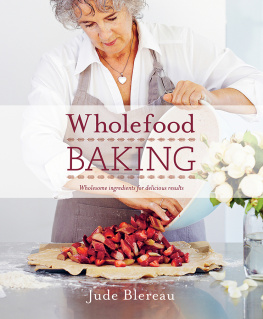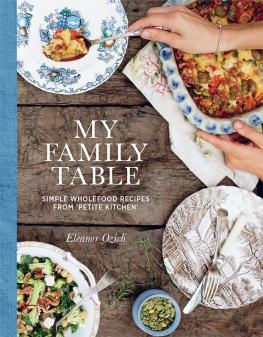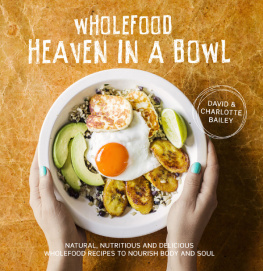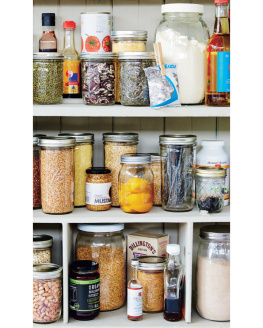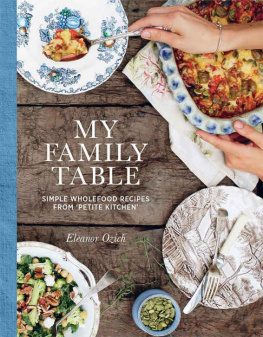
Wholefood expert Jude Blereaus focus is on feeding young children for good health and happiness. From babys first solids at six months to substantial meals and snacks for seven-year-olds, Jude offers recipes that are as nourishing as they are delicious. Children require fuel to play, grow and learn, and nurturing them with real, preferably organic, food will establish good eating patterns for life.
Wholefood for Children is presented in two parts. Firstly, an introduction to the wholefood kitchen and building a real-food culture for your child; then a recipe section of over 165 breakfasts, lunches and dinners, plus ultra-convenient lunchbox treats, and cakes and party food for special occasions.
JUDE DOES SUCH A BEAUTIFUL JOB OF INSPIRING PEOPLE TO STRIVE TO CREATE A DELICIOUS FOOD CULTURE, ANCHORED IN REAL FOOD, IN THEIR OWN HOMES. ILL BE BUYING THIS BOOK FOR A LONG LIST OF FRIENDS.
Heidi Swanson, author of Super Natural Cooking
Jude Blereau was living a wholefood life long before wholefood became a buzzword for healthy living. She is the most authoritative, long-established writer in that field in Australia today, having been actively involved in the organic and wholefood world for over 25 years. Her focus is on helping people learn about good food, and giving them the tools to make healthy, wholesome eating a delicious part of everyday life. Jude has also written Wholefood, Coming Home to Eat, Wholefood Baking and Wholefood from the Ground Up.
wholefoodcooking.com.au
instagram@judewholefood
For Fran, Josh, Zac and Charlie-Jane. With much love, Jude.
For me, writing a book is like having a baby and, once conceived, each has their own personality. I tell my daughter Nessie, an only child, that she has books for siblings! Each of my books grow in my heart, and I feel it is my task as a writer to shape it with my head. But just as it takes a village to raise a child, it certainly takes many to bring a book baby into the world.
This baby is incredibly blessed to have had the benefit of two fairy godmothers: my publisher Kay Scarlett, who, with stars in her hair but feet firmly planted on the ground, has supported this work, and my dear friend Vanessa, who suggested that I start doing cooking classes for young children and who gave me the confidence to go forward. Thank you to both.
I am always encouraged, loved and supported by my beautiful daughter Nessie and, at the core of my work, much of what I do is for her. Thank you my darling.
I am incredibly grateful to all who have helped and supported this work: Rich gave me the space to write; my Best Friend Forever Nene, who cooked me great dinners throughout this project and encouraged and supported me as only a BFF can; Dr Julie Stone, who, in her work as an infant, child and family psychiatrist and as a dear friend, contributed to this book in many insightful and loving waysanother godmother; my family and all my dear friends: Gabrielle Kervella, Alan Cockman, Dean, Nola, Tess, Denise and Peter.
To my editors, Jane Massam, Belinda So, Desney King and Christine Osmond, thank you for taking my words and recipes and making them the best they could be. Thank you to Vivien Valk and Yolande Gray for designing such truly beautiful pages, and to the many others at Murdoch Books who enable me to write.
Many continue to inspire and thus nourish me. I am incredibly grateful to Jessica Prentice, Heidi Swanson, Myra Kornfeld, Peter Berley, Holly Davis, Sophie Zalokar and Irene Verteramo.
Y
Y
Y
Y
Y
Y
Y
Y
Y
Y
Y
Y
Y
Y
Introduction
WHEN MY BEAUTIFUL BABY GIRL was placed in my arms some 27 years ago, I knew beyond a shadow of a doubt that I wanted to nourish her in every possible waywith good food to build a strong and sound body, and with love, beauty, laughter and joy to feed her soul. This was my primary instinct and overwhelming desire. At that time I was living a very busy life as a fashion designer and was only at the beginning of my wholefoods journey, but I had grown up in a family with a strong culture of real food and it was natural for me to continue this practice with my daughter. I made simple food to feed a growing baby and used some pre-made commercial food for conveniencewith Mum standing by to advise me.
But now things are shifting, and many of todays young adults have not had the benefit of a mother (or father) at home who understands what good food is, and how to prepare it. Traditionally, this is something that is passed on from parent to child, from generation to generation and constitutes part of ones food culture.
Over the past 40 to 50 years, quietly and almost imperceptibly, this essential wealth of knowledge of ones food culture has been all but lost.
As a true child of the 60s and 70s I find this disturbing. While you might see me looking quite conservative these days, in my soul Im still wearing Indian cotton dresses and flowers in my hair, I have pretty beads on my ankle and love listening to Neil Young. As young women we burned our bras and fought to have it all.
Our children are a gift and a blessing.
Me with my daughter Nessie, circa 1986.
But now, at 55, I find myself wondering about the legacy of that fight. Im seeing a whole generation of young women whose mothers were out having that brilliant careerI had that brilliant career back in my fashion days, and I can tell you its hard to come home after a day at the office and organise dinner for yourself, let alone for your children, day after day, week after week, year after year. Something always gives. We are in great danger of losing our most essential of wisdoms about foodwhat makes it good, how we cook and eat it, and the importance of deliciousness.
This push to have it all and have it now has created a profound disconnection that often seduces us into accepting pre-prepared, processed foods that promise health and convenience in one easy package. But such foods cannot provide the nutrients and goodness required to build and run a human body and soul. Without a strong food culture, its easy to be sidetracked by such things as hiding or disguising vegetables to make them seem palatable to young children, rather than providing good, solid food fundamentals. It is these fundamentals, more than anything else, that will nourish young children and enable them to grow and bloom to their full potential.
The food culture handed to me by my mother could best be summed up as all things in moderation. It has since been shaped by many other influences: the work of people such as Annemarie Colbin, whose book Food and Healing made so much more sense to me than the fractionalised approach to food I came across when I was studying nutrition; my early macrobiotic days; the incredible legacy of knowledge left by dentist Dr Weston Price, who documented happy, healthy traditional cultures; the ancient Ayurveda, the 5000-year-old practice of natural healing. And Im still learningHolly Davis and Jessica Prentice have recently taught me what I now know about lacto-fermentation, for example.
My food culture has also been shaped by the many mistakes Ive made. It would be fair to say that in my earlier days I was extremeI felt the only path was to be vegetarian, and even a touch vegan. After World War II, food production began to become highly industrialised, and the societal food culture pendulum swung strongly in that direction. Its my belief that the vegetarian, vegan and macrobiotic movements were the only way we baby boomers and flower children knew how to voice our sense that all was not well. While these movements had and still have much to offer, I have found their viewpoints on what makes food healthy or not to be somewhat restricted. I remember my daughter telling me some years ago on Mothers Day how much she loved going to her Nonnas because she could have meat! It was an important lesson. I love the understanding Ive arrived at nowI feel much more centred and grounded in my views and Im very grateful to all who have helped form them. I have found that there is no one size fits all philosophy, and its generally not what a food is that makes it bad, but how its grown and what we do with it. My food culture could now be best summed up as all things real and as little refined as possible, that are compatible with you, in moderation and balance.

